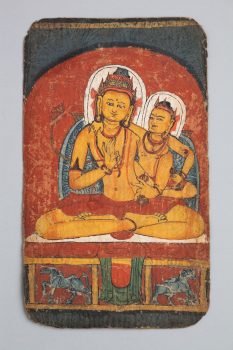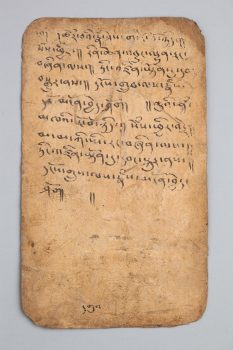Tibet
ca. 14th century
Also known as vajra position, this posture is associated with meditation.
Tibet
ca. 14th century


Translations of Tsakali texts by Namgyal Nyima for David Nalin
༄།། ཚོར་བའི་རྣམ་ཤེས་གི་ [ཀྱི་]ངོ་བོ་ཉིད།། {སེཾས་}སེམས་ཕྱིར་(add: མཚན་ཉིད་མ་སྐྱེས་པ)།། རིན་ཆེན་འབྱུང་ལྡན་རང་བཞིན་ལས།། ཏིང་འཛིན་{ཡོཏན་}ཡོན་ཏན་དུ་དབང་བསྒྱུར་[བསྐུར་]ན་[ནས]།། དངོས་གྲུབ་ལས་རྣམས་མངོན་བྱེད་ཤོག་།། ཆུའི་{ནཾ་}ནམ་མཁའི་ངོ་བོ་ཉིད།། {སེཾས་}སེམས་ཕྱིར་འདྲེ་[འགྲེ་?](add: མཚན་ཉིད་མ་སྐྱེས་པ)]།། མ་མ་ཀི་ཡི་རང་བཞིན་ལས།།ཏིང་འཛིན་{ཡོཏན་}ཡོན་ཏན་དུ་དབང་བསྐུར་ནས།། དངོས་གྲུབ་ལས་{རྣཾས་}རྣམས་མངོན་བྱེད་ཤོག་
tshor ba’i rnam shes kyi ngo bo nyid / sems phyir (add: mtshan nyid ma skyes pa) / rin chen ‘byung ldan rang bzhin las / ting ‘dzin yon tan du dbang bsgyur nas / dngos grub las rnams mngon byed shog. chu’i nam mkha’i ngo bo nyid / sems phyir ‘gre (add: mtshan nyid ma skyes pa) / ma ma ki yi rang bzhin las / ting ‘dzin yon tan du dbang bskur nas / dngos grub las rnams mngon byed shog.
Among the mind’s unborn characteristics, the essential nature of the sensory consciousness is the nature of Ratnasambhava. From that nature, the empowerment of samadhi as good qualities is bestowed. Through that, may the functions of siddhi become actualized. Among the mind’s unborn characteristics, the essential nature of water’s space is the nature of Mamaki. From that nature, the empowerment of samadhi as good qualities is bestowed. Through that, may the functions of siddhibring one to realization.
KEY:
༼archaic ༽
[misspelling]
{contraction}
(addition)
[{misspelling and contraction}]
((numerical code))
<>-? unable to read
A religious movement that originated in India around the fifth to seventh century with sacred writings and esoteric teachings and practices transmitted from teacher to student through initiation. These remain an important part of Hinduism and Buddhism today.
A meditation technique primarily used in tantric practice that involves imagining a deity in one’s mind or imagining oneself becoming a deity and carrying out various activities. Such techniques are intended to help a practitioner transform ordinary perception and achieve enlightened qualities.
Prescribed practices that carry symbolic meaning and value within a specific tradition and are intended to attain a desired outcome. Rituals are usually done as part of a ceremony or regular routine.
An awakened being who understands the true nature of reality and is free from the cycle of birth, death, and rebirth. While there are many buddhas, Siddhartha Gautama is the historical Buddha, whose teachings became the foundation of Buddhism.
Today, Tibetans primarily inhabit the Tibetan Plateau, situated between the Himalayan mountain range and the Indian subcontinent to the west, Chinese cultural regions to the east, and Mongolian cultural regions to the northeast. During the 7th to 9th century, Tibetan rulers expanded their empire across Central Asia, and established Buddhism as the state religion.
Get the latest news and stories from the Rubin, plus occasional information on how to support our work.